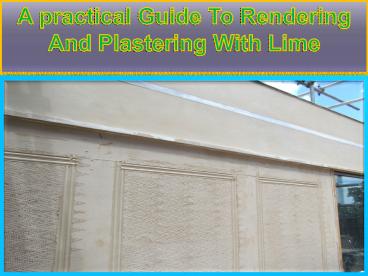A practical Guide To Rendering And Plastering With Lime - PowerPoint PPT Presentation
Title:
A practical Guide To Rendering And Plastering With Lime
Description:
Lime renders were traditionally applied to give protection to walls built of poor quality rubble stone or porous brick or to walls in exposed locations facing driving winds. They help by acting like a sponge, absorbing rainfall then allowing it to evaporate rather than soak into the wall – PowerPoint PPT presentation
Number of Views:34
Title: A practical Guide To Rendering And Plastering With Lime
1
A practical Guide To Rendering And Plastering
With Lime
2
Lime renders were traditionally applied to give
protection to walls built of poor quality rubble
stone or porous brick or to walls in exposed
locations facing driving winds. They help by
acting like a sponge, absorbing rainfall then
allowing it to evaporate rather than soak into
the wall. Most cottages and houses built of
rubble stone would have been rendered originally
and they tend to suffer from penetrating damp if
the lime render is removed or replaced with a
cement rich render.
3
(No Transcript)
4
(No Transcript)
5
There is a very wide range of types of lime
rendering. Rubble walls of many vernacular
buildings were often treated with just a single
coat of render, amounting to not much more than a
very full, flush pointing. Such a render is
thicker in the hollows and very thin over the
stone faces. There was no attempt to create a
flat surface so the undulations of the wall and
even some of the stones themselves were not
concealed. For a smarter finish or on more
prestigious buildings the aim would be for a more
uniform render achieved by applying a scratch
coat to fill the hollows and take up some of the
unevenness followed by one or two more coats
which were worked to a flatter surface.
6
(No Transcript)
7
(No Transcript)
8
Sometimes joint lines were ruled into the damp
top coat to create the illusion of ashlar stone,
but a common finish for many houses and cottages
was a rough-cast where the final coat consisted
of a mortar slurry containing coarse grit applied
by throwing from a special trowel. For interiors
a fairly smooth surface could be obtained using a
coarse render mix, but for top quality internal
plastering the final coat would be richer in lime
and polished up to a smooth, close finish.
9
(No Transcript)
10
Renders and plasters can be applied to a variety
of backgrounds including earth (which should
nearly always be rendered), stone and brick.
Plaster is also applied to wooden laths for
ceilings and internal partitions.
11
By carefully selecting appropriate aggregates it
is possible to match existing renders and
successfully repair failed patches without the
need for complete re-rendering. Hollow or
detached plaster can sometimes be consolidated
and saved and further advice should be sought
before replacing it, especially if it is very old.
12
(No Transcript)
13
(No Transcript)
14
For stone and brick any hollow or decayed render
should be hacked off and any loose pointing
should be raked out and replaced prior to
rendering. Brush the wall to remove loose
material. Do not rake out pointing to provide a
key. Do not use plastering bead on corners as
this will give a modern appearance. Do not use
chicken wire or metal lath to form a key as it
can cause stress in the render due to
differential thermal movements and can lead to
large-scale failure, especially when it rusts.
15
(No Transcript)
16
For more update , visit us
https//limetec.co.uk/lime-render/































